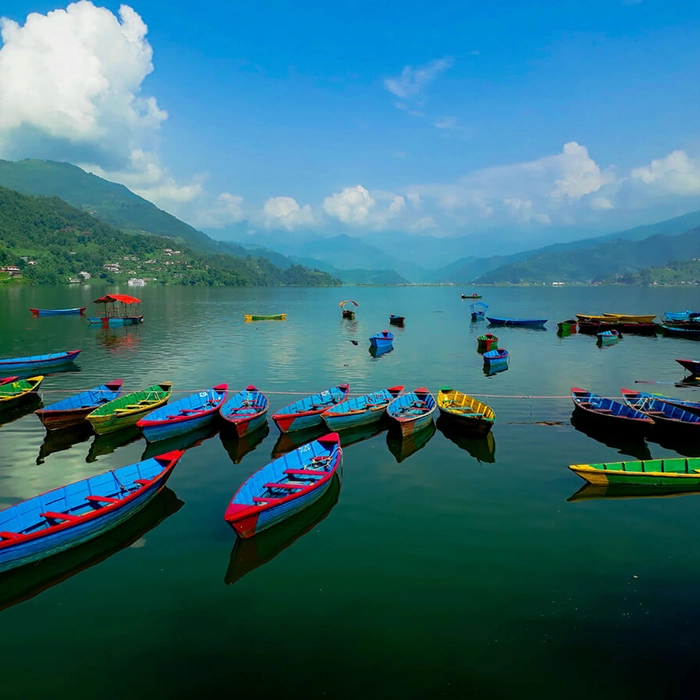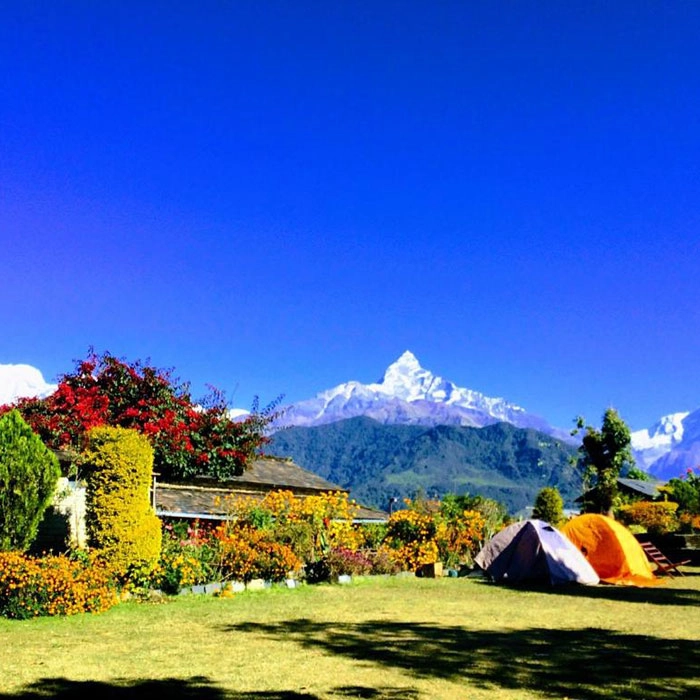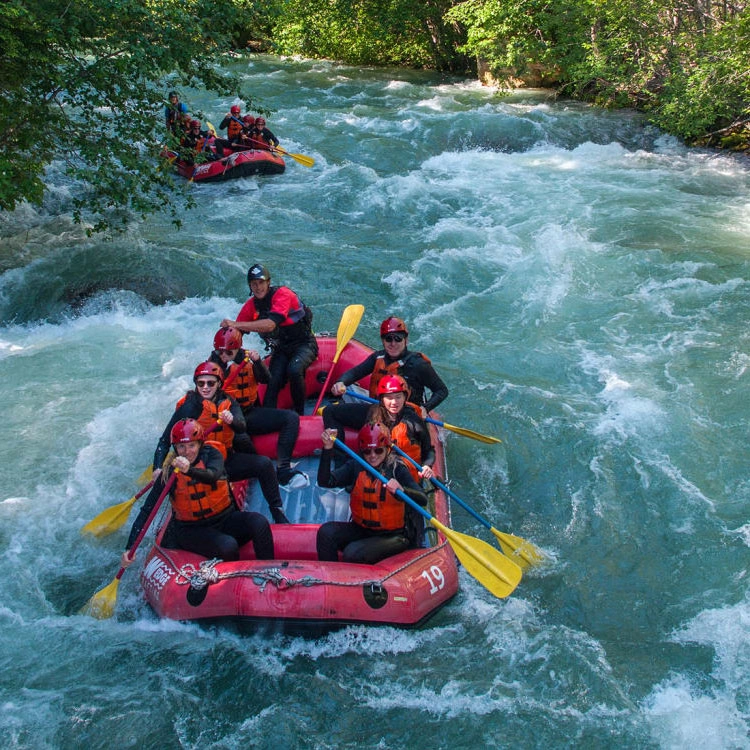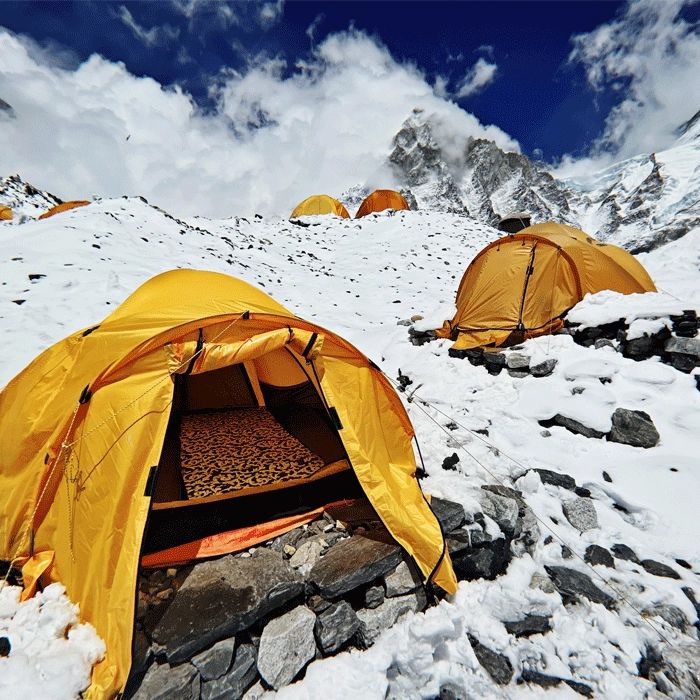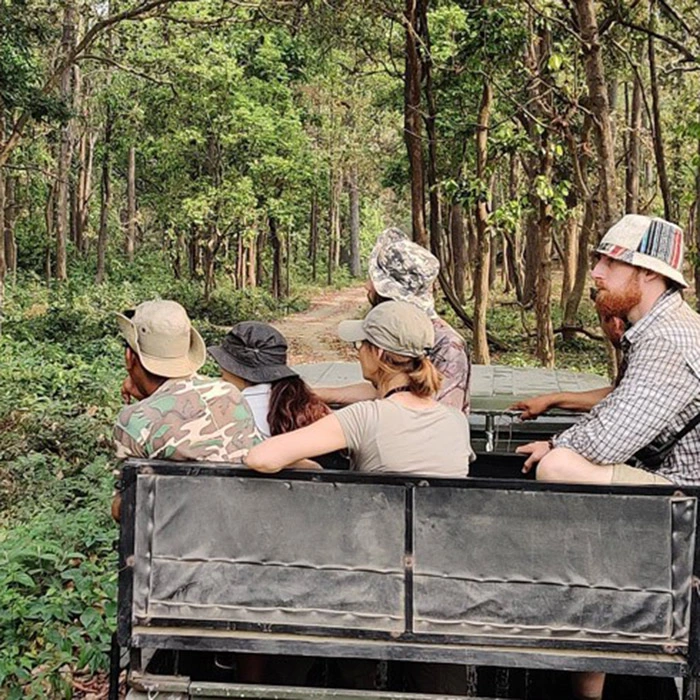GOKYO LAKES TREK
US$2,250.00
/pp
-
15 Days
-
Everest
-
Spring/Autuman
-
Trekking
-
5,360 Meters
-
Hard
-
Car/Plane
-
01-16 People
-
JH#224
 Overviews
Overviews
Your Gokyo Lakes Trek adventure begins in Kathmandu, the vibrant capital of Nepal. Here, you can immerse yourself in the rich culture and history of this Himalayan nation. As you explore the bustling streets and ancient temples, anticipation builds for your trek to Gokyo Lakes. The Gokyo Lakes Trek offers an unforgettable experience, showcasing stunning Himalayan beauty. Known as Sagarmatha in Nepali and Chomolungma in Tibetan, Mount Everest is the highest peak in the world. As you trek toward Everest Base Camp, you’ll enjoy breathtaking sights of iconic mountains such as Ama Dablam, Lhotse, and Nuptse. This journey is rewarding and visually captivating for nature lovers and adventure seekers. Starting from Lukla, the Gokyo Lakes trek takes you along a direct route to Namche Bazaar. Here, you’ll experience the heart of Sherpa culture. Next, you’ll visit the renowned Tengboche Monastery, a spiritual hub in the mountains that offers stunning views of Ama Dablam. From there, ascend to Kala Patthar, where you’ll be greeted by panoramic vistas of the Himalayas. For many trekkers, Gokyo Ri (5,360 m) is the most scenic peak in the Everest region. The views from the summit are spectacular, showcasing the surrounding eight-thousanders. Unlike the often-crowded trails leading to Everest Base Camp, the route to Gokyo offers solitude and tranquility. This makes it an ideal choice for those seeking a deeper connection with nature. With its pristine lakes and dramatic landscapes, the Gokyo Lakes Trek promises an experience like no other. Whether you’re a seasoned trekker or a first-time adventurer, this journey will leave you with memories to cherish for a lifetime. Join us for an extraordinary trek through one of the most beautiful regions in the world! Gokyo Lakes Trek DifficultyThe Gokyo Lakes Trek is a moderate to challenging trek, ideal for trekkers with a good level of fitness and some high-altitude experience. The trail features steep ascents and descents as it traverses rugged terrain, reaching elevations up to 5,357 meters (17,575 feet) at Gokyo Ri, which offers stunning panoramic views of the Himalayas. Trekkers typically walk 5 to 7 hours a day, navigating rocky paths and occasional snow-covered sections, especially near the pass. While no technical climbing skills are required, the high altitude and variable weather conditions demand proper acclimatization, physical endurance, and mental preparedness. The trek rewards adventurers with breathtaking alpine lakes, glaciers, and spectacular mountain vistas. Gokyo Lakes Trek CostThe Gokyo Lakes Trek cost usually includes all essential services such as a licensed guide, porter assistance, necessary permits, teahouse accommodation, meals during the trek, and ground transportation. Solo trekkers receive personalized support, while groups benefit from discounted rates that decrease as the group size grows. We also offer special seasonal discounts during the off-peak months to make this stunning Himalayan trek even more affordable. Although our website shows standard global pricing, you can contact us directly for private group bookings to get the best possible price with top-quality service.
 Itinerary (Plan)
Itinerary (Plan)
Arrive in Kathmandu, Nepal's vibrant capital, where you'll be warmly welcomed with marigold garlands. After transferring to your hotel, take time to relax and acclimate to the bustling city. Discover vibrant local markets, indulge in traditional Nepali dishes, and delve into Kathmandu's rich cultural tapestry. This initial day is perfect for easing into your journey, setting the stage for the exciting adventures ahead in Eastern Nepal. A representative from Jagadamba Holidays will ensure a smooth and pleasant arrival.
Optional Evening Activity:
If you wish, you can spend your evening experiencing the Pashupatinath Aarti, a captivating religious ceremony held at the Pashupatinath Temple. The Aarti usually begins around 6:00 PM and lasts for approximately an hour. This ceremony is a mesmerizing display of traditional music and rituals, providing a profound insight into Hindu spiritual practices. Please check the exact time for the Aarti on the day of your visit, as it may vary. This option is not included in the standard itinerary but offers a unique opportunity to immerse yourself in local culture.
Normally, we book a flight from Kathmandu to Lukla (2,846 m / 9,350 ft.); however, if we are unable to secure a direct flight for some reason, we will need to take an alternative flight option via Ramechhap. If our flight to Lukla is scheduled from Manthali and we have extra time, we will explore the Kathmandu Valley before driving to Manthali for an overnight stay. However, if time is limited, we will depart from Kathmandu at 2 AM to catch the flight on Day 2. This will take approximately four hours to cover the distance of 132 kilometers to Manthali.
This early departure ensures that we arrive in time for the first flight from Ramechhap to Lukla, which departs at 6:30 AM. We will leave Kathmandu according to our scheduled departure time to guarantee a smooth journey to the airport.
Upon arrival at Lukla, your guide will introduce you to your porter. After a brief tea break, we will commence our trek to Phakding (2,620 m / 8,595 ft.). Phakding, a picturesque village and the largest settlement in the area, serves as an ideal first stop for many trekkers spending their initial night in the mountains. Once you arrive in Phakding, you'll enjoy a one-hour break to relax and take in the stunning surroundings. It is recommended to meet with your guide in the lobby afterward to discuss the evening's activities and the schedule for the following day.
Following your refreshment break at Lukla, embark on your trek to Phakding, traversing the scenic route through Nurning Ghat (2,590 m). The trek covers about 8.5 kilometers and takes approximately 3 to 4 hours. During this journey, you will ascend 190 meters and descend 380 meters.
After your breakfast at the lodge, embark on your trek to Namche Bazaar (3,440 m / 11,286 ft.), traversing the scenic route through Monjo (2,835 m). The trek covers about 9.5 kilometers and takes approximately 5 to 6 hours. During this journey, you will ascend 860 meters and descend 190 meters.
We embark on a picturesque trek in the Khumbu region along the Dudh Koshi River. Here, we'll cross stunning suspension bridges adorned with colorful prayer flags. As we navigate the trail, we pass through charming Sherpa villages and lush rhododendron forests, steadily ascending while soaking in breathtaking views of majestic snow-capped peaks.
This journey offers both beauty and challenge, making every step worthwhile. Upon reaching Namche Bazaar (3,440 m / 11,286 ft.), the largest Sherpa village and a vital trading hub, we’ll have ample opportunity to acclimatize to the altitude.
Namche Bazaar's vibrant market is bustling with shops, cafes, and bakeries, creating a lively atmosphere against the dramatic Himalayan backdrop. After checking into our lodge, you can relax, hydrate, and enjoy a warm meal. In the evening, we’ll gather with our group to share stories and reflect on the day’s adventures, setting the stage for an exciting acclimatization day ahead.
This trek from Phakding to Namche Bazaar not only showcases stunning vistas but also immerses you in the rich Sherpa culture, making it a memorable part of your Everest Base Camp journey.
Make the most of your rest day in Namche Bazaar by acclimatizing to the altitude and immersing yourself in the stunning beauty of the Khumbu region. After a hearty breakfast, you can either explore the vibrant town of Namche or embark on an optional scenic trek to Khunde, passing through Khumjung village, with a stop at the renowned Everest View Hotel (3,880 m / 12,730 ft.).
This picturesque hike to Khunde offers breathtaking views of the world’s tallest peaks, including Mount Everest, Lhotse, and Ama Dablam. The well-marked trail is relatively steep, rewarding trekkers with panoramic vistas and ample opportunities for memorable photographs. At the Everest View Hotel, take a moment to pause for refreshments while soaking in the magnificent surroundings before continuing your journey to Khunde, a charming Sherpa village rich in culture and history.
Once in Khunde, explore local attractions such as the Sherpa museum and historic monasteries, which showcase the unique heritage of the Sherpa people. After your trek, return to Namche Bazaar for a leisurely lunch and some free time to visit local shops, purchase trekking gear, or unwind at a cozy café with stunning mountain views.
In the evening, gather with your group to share stories from your day and enjoy a warm meal together. This day of exploration and acclimatization not only enriches your experience in the Himalayas but also prepares you for the exciting adventures that lie ahead.
The round-trip trek from Namche Bazaar to Khunde via the Everest View Hotel and Khumjung covers approximately 8.15 kilometers and typically takes 5 to 6 hours. During the journey, you will ascend 550 meters and descend 550 meters.
After enjoying a hearty breakfast at your lodge in Namche Bazaar, embark on a scenic trek to Dole (4,200 m / 13,780 ft) via the breathtaking Mong La Pass (3,975 m). The trek journey covers approximately 11.8 kilometers and takes 6 to 7 hours. During this journey, you will ascend 1,160 meters and descend 550 meters.
As your trek departs from Namche, the trail gradually climbs, leading you through vibrant forests filled with rhododendron and pine trees. The vibrant landscape, rich with diverse flora and fauna, provides a refreshing start to your day. Along the way, keep an eye out for Himalayan wildlife, such as mountain goats, yaks, and the rare, colorful Himalayan pheasants that thrive in the area.
Reaching Mong La Pass is a significant highlight of the day. Here, you can take a well-deserved break while soaking in panoramic vistas of towering peaks, including the awe-inspiring Ama Dablam and Thamserku. From this elevated viewpoint, the surrounding mountains and deep valleys offer perfect opportunities for unforgettable photographs.
After a break, the trail gently descends toward Dole, a peaceful Sherpa village nestled among terraced fields and stone cottages. This part of the trek offers striking landscapes, leading you through alpine meadows and yak pastures. As you walk, you’ll witness Sherpa life unfolding in the quiet charm of the village communities.
Upon arriving in Dole, the cool mountain air greets you, and the village’s serene atmosphere provides a peaceful resting point. Settle into your lodge and enjoy the evening with a warm meal. Take some time to explore the village or simply relax, reflecting on the day's journey while admiring the beautiful sunset over the Himalayan peaks.
This trek from Namche Bazaar to Dole combines cultural immersion with awe-inspiring natural beauty, offering a truly enriching experience in the heart of the Everest region.
After breakfast at your lodge in Dole, embark on a picturesque trek to Machhermo (4,470 m / 14,665 ft), a serene village in the heart of the Everest region. The trek covers approximately 5 kilometers and takes 3 to 4 hours. During this journey, you will ascend 400 meters and descend 50 meters.
The trek begins with a gentle ascent as you leave the peaceful village of Dole behind. The trail takes you through lush alpine meadows, where you’ll notice grazing yaks and traditional stone houses dotting the landscape. As you hike, the scenery opens up to offer breathtaking views of towering Himalayan peaks, including Cho Oyu (8,201 m), the sixth-highest mountain in the world.
The path winds through high-altitude pastures and across small streams, presenting the raw beauty of the Everest region’s rugged terrain. This section of the trek provides a sense of tranquility, with fewer crowds and expansive vistas of snow-capped mountains. As you progress, the thinning air becomes more noticeable, a reminder of the altitude, so take time to acclimatize and enjoy the surroundings.
Before reaching Machhermo, you will pass through the small hamlet of Luza (4,360 m), where a short rest is recommended to catch your breath and soak in the stunning views. Continuing onward, the trail remains relatively steady, with minor ups and downs, offering magnificent panoramas of the surrounding peaks and valleys.
Upon arrival in Machhermo, you will be greeted by the quiet charm of this high-altitude village. Machhermo is known for its yak pastures and is believed to be the site of a famous yeti sighting in 1974, adding an element of intrigue to the visit. You may also want to visit the Machhermo Porter Rescue Center, which provides vital information on altitude sickness and offers a chance to learn more about the health precautions necessary for high-altitude trekking.
After settling into your lodge, enjoy a warm meal and take time to relax. The village offers a peaceful atmosphere, perfect for unwinding after a day of trekking. Spend the evening reflecting on the day’s journey while admiring the views of the Himalayas, which become particularly captivating as the sun sets over the peaks.
This trek from Dole to Machhermo offers an unforgettable combination of awe-inspiring landscapes and insights into the Sherpa culture, making it a memorable experience for trekkers in the Everest region.
Today is your designated rest day in Machhermo, providing you with the perfect opportunity to acclimatize to the high altitude. At an elevation of 4,470 meters, taking time to rest and adjust to the thinner air is essential for your overall well-being during the trek. However, for those feeling energetic and seeking additional adventure, there is an optional hike to Machhermo Peak (4,600 m), offering rewarding panoramic views of the surrounding peaks.
Begin your day with a leisurely breakfast at your lodge, soaking in the peaceful ambiance of Machhermo, a charming Sherpa village known for its breathtaking scenery. If you choose to take a rest day, immerse yourself in the village's charm by engaging with the welcoming locals or relishing the peaceful atmosphere of this high-altitude retreat. Machhermo is also home to the Machhermo Hospital and Rescue Post, where you can learn about altitude sickness and other important aspects of high-altitude trekking from the experienced staff.
For those opting for the optional hike, embark on a short but invigorating trek towards Machhermo Peak. The climb to 4,600 meters presents spectacular vistas of snow-draped summits, featuring the impressive Cho Oyu, the sixth-highest peak globally. The trek features a moderate trail, ensuring accessibility for trekkers with different levels of experience, while the breathtaking views from the summit reward your efforts splendidly. From the peak, you can capture stunning photographs of the Everest region's rugged terrain and vast mountain ranges.
After returning from your hike or spending a relaxing day in the village, enjoy a warm meal at your lodge in the evening. Gather around with fellow trekkers to share experiences while basking in the breathtaking sunset illuminating the surrounding mountains.
Whether you choose to rest or take the optional hike, this day in Machhermo serves as an important part of your acclimatization process, preparing you for the upcoming challenges and breathtaking experiences that await higher up in the Everest region.
The round-trip trek from Machhermo to Machhermo Peak (approximately 4,600 m) covers about 4 kilometers and typically takes 2 to 3 hours. During the journey, you will ascend 270 meters and descend 270 meters.
After enjoying breakfast at your lodge in Machhermo, embark on an exhilarating trek to Gokyo (4,790 m / 15,715 ft), a captivating village nestled alongside the breathtaking Gokyo Lakes. This scenic trek covers approximately 6.9 kilometers and typically takes about 3 to 4 hours to complete. During this journey, you will ascend 390 meters while descending 30 meters.
The path winds through lush valleys and alpine meadows adorned with vibrant flora. The soothing melodies of babbling brooks and the cheerful songs of birds amplify your bond with the natural world. You may encounter herds of yaks and the occasional Himalayan mountain goat along the way, adding wildlife to your adventure.
The ascent is steady, offering stunning views of surrounding peaks, including the imposing Machapuchare and majestic Cho Oyu. The trail gradually leads you alongside the Gokyo Lakes, a series of turquoise glacial lakes known for their breathtaking beauty and serene atmosphere. The colors of the lakes change with the light, providing a mesmerizing spectacle that invites you to pause and reflect.
Upon reaching Gokyo, you will be greeted by the mesmerizing views of the lakes and the towering peaks that encircle them. The village itself is a peaceful haven, perfect for resting and rejuvenating. Once settled into your lodge, take time to explore the area, perhaps venturing to the shores of the lakes for a closer look or simply enjoying the stunning landscapes.
In the evening, gather with fellow trekkers to share stories and experiences while savoring a hearty meal. The tranquil setting of Gokyo, combined with the breathtaking beauty of the surroundings, creates an unforgettable atmosphere for relaxation and reflection after a day of trekking.
This trek from Machhermo to Gokyo is not only a journey through stunning landscapes but also an opportunity to immerse yourself in the natural beauty and cultural richness of the Everest region, making it a highlight of your Himalayan adventure.
Rise early to embark on an unforgettable adventure as you make your way to Gokyo Ri (5,360 m / 17,585 ft.) to witness a breathtaking sunrise. The Gokyo Ri sunrise hike offers an unforgettable experience, taking approximately 3 to 4 hours for a round trip of 3.65 kilometers. You'll ascend and descend 570 meters, enjoying breathtaking panoramic views of the Himalayas, including the majestic Mount Everest.
As you set off in the early morning light, the path leads you through rocky terrain with stunning views of the shimmering Gokyo Lakes below. The cool morning air invigorates your senses, and the tranquil sounds of nature, including flowing streams and chirping birds, enhance your connection with this pristine environment.
Upon reaching the summit of Gokyo Ri, you will be rewarded with spectacular panoramic views of the world’s highest peaks, including Mount Everest, Lhotse, and Makalu. As the sun rises, it bathes the snow-capped mountains in golden light, creating a magical atmosphere perfect for photography and reflection.
After soaking in the beauty of the sunrise, make your way back down to Gokyo village for a well-deserved breakfast at your lodge. Refuel and gather your strength for the day ahead.
Following breakfast, embark on your trek toward Dole (4,200 m / 13,780 ft), a serene village nestled in the heart of the Everest region. This journey covers approximately 12.5 kilometers and takes about 5 to 6 hours, with an ascent of 70 meters and a descent of 590 meters.
As you leave Gokyo, the trail winds through lush valleys and vibrant alpine meadows, offering opportunities to encounter grazing yaks and colorful wildflowers. The scenery is breathtaking, with the backdrop of towering peaks creating a stunning contrast against the greenery.
Upon arriving in Dole, you will experience the peaceful charm of this high-altitude village. Settle into your lodge and take the time to explore your surroundings, interacting with friendly locals and appreciating their rich culture. In the evening, enjoy a hearty meal and share stories with fellow trekkers, reflecting on the day’s adventures and the unforgettable sunrise at Gokyo Ri.
This journey not only showcases the breathtaking natural beauty of the Everest region but also immerses you in the authentic culture of the Sherpa people, making it a truly memorable experience.
After breakfast at your lodge in Dole, set out on an invigorating trek to Tengboche (3,860 m / 12,664 ft.), passing through Phortse Tenga and Phortse along the way. This scenic journey covers 7.35 kilometers and typically takes 4 to 5 hours. During this trek, you'll ascend 470 meters and descend 660 meters.
As you leave Dole, the trail winds through lush forests and offers stunning views of the surrounding mountains. The vibrant rhododendron and pine trees create a serene atmosphere as you make your way toward Phortse Tenga, a charming settlement nestled alongside a rushing river. Take a moment to soak in the beauty of this picturesque spot before continuing your trek.
Continuing to Phortse, you'll encounter traditional Sherpa villages, where you can observe the local way of life and the warm hospitality of the residents. This section of the trek features gentle ups and downs, making it a pleasant experience as you traverse the stunning landscape.
Upon reaching Tengboche, you'll be greeted by the magnificent Tengboche Monastery (3,860 m), one of the most significant Buddhist monasteries in the region. This serene setting offers breathtaking views of the towering peaks, including Ama Dablam, creating a perfect backdrop for reflection and photography.
After settling into your lodge, take time to explore the monastery and learn about its rich history and spiritual significance. In the evening, enjoy a delicious meal while sharing stories with fellow trekkers, surrounded by the stunning beauty of the Himalayas. This trek from Dhole to Tengboche is not just a journey but an enriching experience, offering a perfect blend of cultural immersion and breathtaking natural beauty in the Everest region.
After breakfast at the lodge, embark on your trek to Monjo (2,835 m / 9,301 ft.), traversing the scenic route through Kyangjuma (3,600 m / 11,811 ft.). The trek covers about 15.5 kilometers and takes approximately 6 to 7 hours. During this journey, you will ascend 400 meters and descend 1,450 meters.
As you set out from Tengboche Monastery, the trail takes you through pristine forests of rhododendron and pine, offering breathtaking views of the surrounding snow-capped peaks. The tranquility of the mountains, combined with the vibrant prayer flags fluttering in the wind, creates a spiritual atmosphere that perfectly complements your journey. Along the trail, you will journey through the picturesque village of Kyangjuma, a spot renowned for its sweeping vistas of towering Himalayan giants like Ama Dablam, Everest, and Lhotse. The panoramic scenery here is truly captivating, offering an ideal pause for trekkers to soak in the grandeur of the surrounding peaks.
The descent towards Monjo leads you through scenic river valleys and over suspension bridges that cross the mighty Dudh Koshi River. You’ll encounter traditional Sherpa villages along the way, where the locals greet you with warm smiles and a glimpse into their unique culture. The landscape transitions from high alpine terrain to lush green valleys as you make your way down, showcasing the diversity of the region’s natural beauty.
Upon reaching Monjo, a peaceful village nestled in the Dudh Koshi Valley, you can relax and reflect on the day's journey. Monjo, located at the gateway to Sagarmatha National Park, provides a peaceful and relaxing atmosphere after a long day’s trek. Nestled in the tranquil Dudh Koshi Valley, it serves as a quiet retreat where you can unwind and reflect on the day’s adventures while surrounded by nature’s beauty. Take the time to unwind, appreciate the surrounding views, and prepare for the final stages of your Himalayan adventure.
After breakfast at the lodge, embark on your trek to Lukla (2,846 m / 9,350 ft.), traversing the scenic route through Phakding (2,610 m). The trek journey covers about 12.5 kilometers and takes approximately 4 to 5 hours. During this journey, you will ascend 410 meters and descend 330 meters.
As you set off from Monjo, the trail meanders alongside the rushing waters of the Dudh Koshi River, providing a soothing soundtrack to your adventure. The stunning scenery is adorned with colorful rhododendron forests, rich greenery, and quaint traditional villages, creating a vibrant tapestry that enhances your trekking experience. Watch for local wildlife along the way, such as vibrant birds and mischievous monkeys, as you traverse this captivating landscape.
The journey to Lukla offers more than just reaching your destination; it provides a chance to delve into the rich Sherpa culture that flourishes in this enchanting region. You may encounter friendly locals along the way, offering warm smiles and greetings that enhance your trekking experience. Take the time to appreciate the intricate carvings and prayer flags adorning the monasteries that line the path, which serve as a reminder of the spiritual significance of this region.
As you approach Lukla, the bustling atmosphere of this gateway town comes into view. Known for its famous airport, Lukla serves as the starting point for many trekkers heading into the Everest region. Upon arrival, enjoy a moment to relax and reflect on your journey while soaking in the views of the surrounding peaks.
This trek concludes with a sense of accomplishment and anticipation for the adventures that lie ahead in the majestic Himalayas. Whether you are an experienced trekker or a novice explorer, the journey from Monjo to Lukla through Nurning offers a memorable experience filled with breathtaking landscapes and cultural insights.
After an unforgettable journey through the breathtaking landscapes of the Everest region, it's time to conclude your adventure with a scenic return flight from Lukla to Kathmandu. This flight is not only a means of transportation but also an extension of your Himalayan experience, offering stunning aerial views that will leave you in awe.
As you board the small aircraft, the excitement builds for the final leg of your trek. The flight from Lukla, known for its challenging runway, will take you on a thrilling journey above the majestic mountains you’ve spent days trekking through. As the plane ascends, you'll be treated to panoramic views of the rugged Himalayan terrain, including towering peaks and deep valleys. On a clear day, you might catch glimpses of some of the world’s highest mountains, including Lhotse, Makalu, and, of course, the iconic Mount Everest.
The flight typically lasts about 30 to 40 minutes, providing ample time to soak in the breathtaking scenery. The pilot often maneuvers the plane in a way that allows passengers to see both sides, so be sure to have your camera ready. The vibrant colors of the landscapes below contrast beautifully with the stark whites of the snow-capped peaks, creating a stunning visual tapestry.
Upon arriving at Tribhuvan Domestic Airport, you will be welcomed back to the vibrant city of Kathmandu, where the lively atmosphere and rich culture await your exploration. The transition from the serene mountains to the vibrant energy of the capital is a reminder of the diverse experiences Nepal offers. After collecting your luggage and possibly sharing stories with fellow trekkers, you’ll have the opportunity to explore the rich cultural heritage, delicious cuisine, and lively markets of Kathmandu.
This return flight not only marks the end of your trek but also serves as a perfect conclusion to an adventure filled with breathtaking landscapes, cultural encounters, and personal reflections. Cherish the memories you’ve created in the heart of the Himalayas, as they will stay with you long after your journey concludes.
The buffer day in Kathmandu serves as a crucial safety net during your trekking adventure in the Himalayas. Given the unpredictable nature of mountain weather and the potential for flight delays, this day is designed to ensure a smooth travel experience. By including a buffer day in your itinerary, you can mitigate the impact of unforeseen circumstances and allow for a more relaxed journey.
If your flights operate as scheduled and weather conditions are favorable, this day offers a fantastic opportunity to explore the rich cultural and historical tapestry of the Kathmandu Valley. The valley is a UNESCO World Heritage Site, home to seven remarkable monument zones, each showcasing unique aspects of Nepalese culture and heritage.
You can begin your exploration in the heart of Kathmandu at Durbar Square, where ancient palaces, temples, and courtyards tell the story of the city's royal history. Marvel at the intricately carved architecture of Kastamandap and Kasthamandap Temple, and don’t miss the iconic Kumari Ghar, the residence of the living goddess, or Kumari.
Next, consider visiting Swayambhunath, also known as the Monkey Temple, perched atop a hill overlooking the valley. This ancient stupa is adorned with colorful prayer flags and offers panoramic views of the city and surrounding mountains. The site is also home to many monkeys, adding a playful element to your visit.
For a more spiritual experience, you can head to Boudhanath Stupa, one of the largest stupas in the world. This sacred site is a significant pilgrimage destination for Buddhists and features a bustling marketplace filled with traditional shops and eateries. Here, you can observe the rituals of local monks and engage with the community while enjoying a delicious bowl of traditional Nepali dal bhat.
If you have time, a trip to Pashupatinath Temple, one of the holiest Hindu temples in the world, is a must. Situated along the banks of the Bagmati River, this temple complex is a hub of religious activity, where you can witness traditional cremation ceremonies and explore the serene surroundings.
Throughout your day of exploration, immerse yourself in the vibrant local culture, indulge in delectable street food, and engage with the friendly locals. This buffer day not only acts as a precautionary measure for travel disruptions but also enhances your overall experience in Nepal, allowing you to discover the breathtaking beauty and rich history of the Kathmandu Valley. Whether your journey is uninterrupted or you need to utilize this day for adjustments, it promises to be a memorable addition to your adventure in the Himalayas.
Concluding Your Journey in Nepal
As your remarkable journey through the Himalayas comes to an end, take a moment to reflect on the awe-inspiring natural beauty, rich cultural heritage, and memorable experiences that have defined your time in Nepal. From the majestic mountain landscapes to the warm hospitality of the local communities, every moment has contributed to an unforgettable adventure.
Airport Transfer by Jagadamba Holidays
To ensure a smooth and timely departure, an official representative from Jagadamba Holidays will collect you from your hotel 3.5 hours prior to your scheduled flight departure. Our team is committed to providing a reliable and comfortable transfer service to Tribhuvan International Airport, allowing you to conclude your journey with peace of mind.
We sincerely appreciate your trust in Jagadamba Holidays and hope to have the pleasure of serving you again on your future journeys.
Quotation 2025
| Group Size (Pax) |
1 - 2 |
3 - 4 |
5 - 6 |
7 - 8 |
9 - 12 |
13 - 16 |
17 - 20 |
21 - 24 |
25 - 32 |
| Cost Per Person |
$2,025 |
$1,995 |
$1,965 |
$1,935 |
$1,905 |
$1,875 |
$1,845 |
$1,815 |
$1,785 |
 Cost Include
Cost Include
- All transfers within Nepal are included as per itinerary
- Any domestic flight of Nepal as per trekking itinerary
- Trekking accommodation (hotel, lodge and/or tent) as per itinerary
- Small shared room with shared bathroom during trek in Nepal
- In Kathmandu and/or Pokhara: Stay at ***Hotel with breakfast
- Luggage for porters during the trek (12.5 kg/person)
- Enjoy unlimited breakfast, lunch, and dinner throughout the trek.
- Unlimited tea or coffee for breakfast during the trek
- An English speaking guide (trekking/tour) as per Itinerary
- Travel insurance for trekking staff (guides and porters)
- All expenses of trekking staff(s) during trekking
- Includes all conservation, national park, trekking, and climbing permits
- Sightseeing / Wildlife tours if included in the itinerary
- Farewell dinner in Kathmandu before returning home
 Cost Exclude
Cost Exclude
- Single room/single tent surcharge (on request)
- Round trip/one way international flight ticket to Nepal.
- Tourist visa for Nepal (30-50 $, depending on length of stay)
- Personal Insurance (covers: Trip/flight cancellation, helicopter rescue)
- Meals (lunch, dinner) at hotels in Kathmandu, Pokhara and other cities
- Drinks (soft, hot or mineral/boiled water) during the lodge trek
- Any personal trekking and/climbing equipment for trekking in Nepal
- Hotel expenses in case of early return from trekking for any reason
- Costs due to flight cancellations & extra porters/horses during the trek
- Additional costs incurred due to any reason beyond Jagdamba’s control
- More evidence about pandemics like COVID-19 if needed in the future.
- Personal expenses during the trek (phone, wifi, shower, charging etc.)
- Other costs and things that are not mentioned in the service inclusion
- Gratuity for trekking staff (recommended: 9€ /10$ per traveler per day)
|









 Overviews
Overviews
 Trip Overview
Trip Overview
 Travel Itinerary
Travel Itinerary
 Cost Include
Cost Include
 Cost Exclude
Cost Exclude
 Fixed Departure
Fixed Departure
 Route Map
Route Map

 Freqeuntly Asked Questions
Freqeuntly Asked Questions
 Reviews And Rating
Reviews And Rating
